
Advisory Committee Recommends Continued Investment in Jefferson Lab |
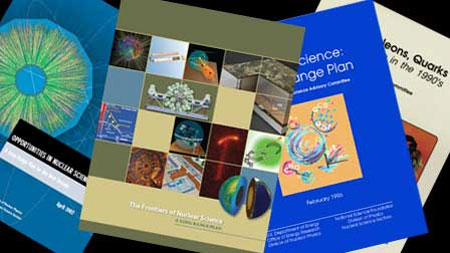 Pictured are some of the physics research, long-range planning documents that the Nuclear Science Advisory Committee has provided input to over the years.
A committee appointed by the U.S. Department of Energy and National Science Foundation to review and recommend the future course of nuclear physics research in the United States issued a report supporting the continued funding of the experimental program at Jefferson Lab. The report was posted on Feb. 1. The Nuclear Science Advisory Committee, which provides advice to the DOE and NSF on the nation's program for basic nuclear science research, considered the future of all research programs funded by the agencies under three funding scenarios, a modest-growth and two no-growth federal budgets. NSAC, in turn, appointed a special subcommittee of scientists to review the programs, which include the three largest nuclear science research programs...... more |
|
|
Neilson Receives Secretary of Energy's Excellence Award
|
Energy Secretary Chu Won't Serve Second Term
|
U.S. Patent Office Publishes Rules for New First-Inventor-to-File System
|
||
|
|
||||
Below the Fold:
|
||||
|
|
||||
Advisory Committee Recommends Continued Investment in Jefferson Lab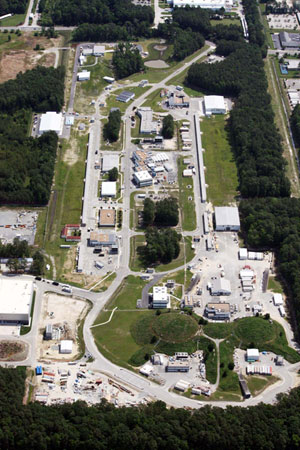 This aerial view of the Continuous Electron Beam Accelerator Facility shows the footprint of the accelerator and the experimental halls where nuclear physics experiments are conducted .The newest experimental facility, Hall D, which is part of the 12 GeV Upgrade, is visible in the upper left.
JA committee appointed by the U.S. Department of Energy and National Science Foundation to review and recommend the future course of nuclear physics research in the United States issued a report supporting the continued funding of the experimental program at Jefferson Lab. The report was posted on Feb. 1. The Nuclear Science Advisory Committee, which provides advice to the DOE and NSF on the nation's program for basic nuclear science research, considered the future of all research programs funded by the agencies under three funding scenarios, a modest-growth and two no-growth federal budgets. NSAC, in turn, appointed a special subcommittee of scientists to review the programs, which include the three largest nuclear science research programs – the Continuous Electron Beam Accelerator Facility (CEBAF) located at Jefferson Lab, the Relativistic Heavy Ion Collider (RHIC) at Brookhaven National Laboratory and the future Facility for Rare Isotope Beams (FRIB) at Michigan State University. The committee's leading recommendation concerned a modest-growth budget: "The future science potential was a major ingredient in the subcommittee's assessment of how the budget scenarios … would impact the field. Of the options considered, the subcommittee was unanimous in endorsing the modest-growth budget scenario as the minimum level of support that is needed to maintain a viable long-term U.S. nuclear science program that encompasses the vision of the LRP (Long Range Plan)." The Long Range Plan for nuclear physics research was developed by NSAC in 2007. In that plan, completion of the 12 GeV Upgrade at Jefferson Lab was the first of four recommendations. Construction on the 12 GeV Upgrade to expand the research capabilities of Jefferson Lab began in 2009. The committee noted this effort in discussing no-growth situations: "In developing this report, the subcommittee has considered the impact on the U.S. nuclear science program under three different budget scenarios. Two of them provide no growth. The third would provide modest growth. The recommendations that were made for these different scenarios must be viewed as a snapshot in time that reflects the state of the field today. This view led the subcommittee to conclude that under all scenarios we must capitalize on the investment that has been made to upgrade CEBAF." The committee further stated that under a no-growth budget, either RHIC or FRIB implementation would have to shut down. RHIC is an existing facility, while FRIB is yet to be constructed. "Because of the superb science lost in either shutting down RHIC or terminating construction on FRIB, the committee was not able to make a choice based on scientific merit alone. Based on additional considerations of timing of the budget crisis relative to the status of the ongoing construction initiative, the subcommittee vote, while closely split, resulted in a slight preference for the choice that proceeds with FRIB," the report says. Jefferson Lab Director Hugh Montgomery noted that the committee was faced with a difficult task. He said that any cuts in funds will harm all U.S. research facilities, while jeopardizing U.S. leadership in nuclear physics research and slowing future advances the field will make in understanding the complex nature of our universe. He noted further that reduced funding will adversely impact regional economies and, importantly, limit training and educational opportunities for future scientists, engineers and science-related specialties. Montgomery said he will work with the directors of RHIC at Brookhaven National Lab and of the FRIB project at Michigan State University to seek congressional support for a modest-growth budget, which would provide a 1.6 percent increase, or roughly $50 million more in Fiscal Year 2014, to keep all three programs operational. "Our national research labs have made many important contributions, from developing new technologies and new energy sources to enhancing national security and improving our health and well being," Montgomery said. "Cuts in the budget send a wrong message, telling the next generation of scientists from around the world who use our facilities and who are engaged in the basic sciences, particularly in discovering the fundamental nature of nuclear matter, that they might do better to look elsewhere to conduct their research." In its report, the committee stated: "It is difficult to forecast the future impact of a field like nuclear science whose goal is to understand the origin, evolution, and structure of visible matter in the universe. However, history shows that breakthroughs in technology nearly always have come either from science discoveries that ‘had no apparent application’ or from developing the tools that were needed to make the discoveries." Editor's note: This article was posted earlier this month on Jefferson Lab's main webpage at: www.jlab.org. |
||||
|
|
||||
Steve Neilson Receives Secretary of Energy's Excellence Award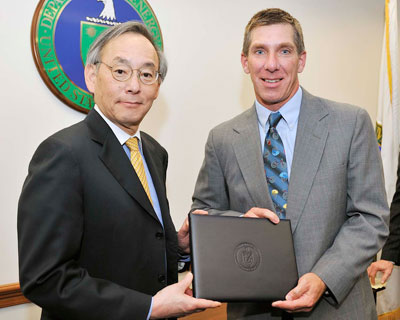 Steve Neilson (right), a member of the Department of Energy's Site Office staff at Jefferson Lab, was recognized by Secretary of Energy Steven Chu on Jan. 16 at DOE headquarters. Neilson received the Secretary's Appreciation Award for Management and Operational Excellence at a secretarial appreciation awards event. Ken Shipp/DOE Photo
In retrospect, it seems that every career step Steve Neilson has taken has in some way helped prepare him for his current position as safety and occupational health manager in the Department of Energy's Site Office at Jefferson Lab. Neilson grew up in the suburbs of Flint, Mich., in a third generation of autoworkers for General Motors. But Neilson knew that a career in the auto industry wasn't for him. "I had aspirations beyond factory work," he recalled recently. "I drew a lot of inspiration from coaches, teachers and other role models as I was trying to find my way in the world." He entered the University of Michigan-Flint as a pre-pharmacy major, but discovered that chemistry wasn't his strong suit and switched to biology. One professor who was particularly influential in his life introduced him to research in the Mammoth Cave system, studying cave crickets in a unique ecosystem, and then, after his graduation in 1987, helped him land an internship as a medical technologist. His one year internship included much the same studies that first-year pathology residents went through, minus, he noted, the autopsies. After landing a full-time job at the University of Cincinnati Medical Center, he took advantage of the university’s tuition reimbursement, working third shift in the clinical chemistry lab and taking master's classes part time during the day. His long commute made it impossible for him to drive home and get back for classes, so he'd catch some sleep in the medical school library. After a few years as a part-time student in the Industrial Hygiene Program, he got a lucky break when a student who was on a full grant dropped out of the program. Neilson won the slot, which allowed him to become a full-time student who only needed to work part time. "Having been a med tech was a great background for me," he pointed out. "Industrial Hygiene is a broad field, but at its core it's about preventive medicine and understanding the biological implications of exposures. It was a good fit." After receiving his master's degree, he set out on a job search that he describes as "extensive," and he kept the stack of rejection letters to serve as motivation. Ultimately, he landed a contract term position with the National Institute for Occupational Safety and Health (NIOSH), an entity within the Department of Health and Human Services that falls under the Centers for Disease Control. He worked as part of a team evaluating the health effects of rubber-modified asphalt on paving crews in Michigan, Florida and California. Although the work required a great deal of travel – and being away from his family often for weeks at a time – it was work that strengthened his resume and expanded his experience. And it landed him a federal position in the spring of 1995 with the Navy at the Crane Naval Surface Warfare Center in Southwest Indiana. That 100-square-mile facility was in many ways a self-contained city, complete with all of the public works trades and even its own railroad. Research and work conducted there ranged from electronic warfare and submarine battery development and testing to explosives sciences and refurbishing long-range radar arrays for Navy ships. Neilson remarked that it was a great place to cut your teeth as an industrial hygienist. In 2001, Neilson accepted a position as a Safety and Health Manager with the Army Corps of Engineers at the NASA Plum Brook Nuclear Reactor Decommissioning Project in Sandusky, Ohio. There, Neilson got what he calls his "baptism by fire" in the field of Industrial Safety. His Navy experiences, including some familiarity with radiation safety and linear accelerator operations, helped him acclimate to the decontamination and decommissioning project. "It was like walking into a time capsule," he recalled of the D&D project. "When the funding for the research reactor was cut-off in the early 70’s, the NASA scientists simply walked out. We'd go into offices and there would still be writing on the chalk boards just as they left it. It was eerie." The work was classic industrial safety, he noted. Right off the bat, he had to attend crane inspection school to contend with the challenge of using 40-year-old cranes that had been basically sitting idle for more than 30 years. It was there, as well, that he learned the diplomacy that his position at Jefferson Lab would ultimately require, since he oversaw contractors work performance. "That job helped me prep for the one here," he said. "I was tasked with both oversight responsibility and making sure that the contractor succeeds. I learned how to focus on vulnerabilities to success, be part of working them out, and deal with things in such a way that not everything is a crisis. If you just throw grenades without offering assistance, you're not bringing anything to the table." After three years at Plum Brook, those aspirations that propelled him out of Michigan began to goad him once again. He had visited the Williamsburg area several years prior while attending a safety class sponsored by the Navy, and had been taken with the area. When a position became available in the Thomas Jefferson Site Office (TJSO), he jumped at the chance and arrived in 2004 as an OSH specialist. He was promoted a few years later to his current position. In mid-January, Neilson received the Secretary of Energy's Appreciation Award for Management and Operational Excellence. The award was primarily for his aggressive efforts to work with lab personnel to elevate the awareness of silica hazards and reaffirm expectations for safety, according to the certificate he received. He was recognized for his leadership in this work, including sharing his experiences and challenges on managing silica exposures across the DOE system and at a forum organized by the Office of Health, Safety and Security (HSS) at the 2012 American Industrial Hygiene Conference. He also has worked with DOE headquarters to shape a pending silica hazard awareness document and, through that work, helped focus the messages for the DOE-wide audience. "This is an issue that's not specific to Jefferson Lab," he noted. "My message to everyone is that if you're not actually collecting samples to confirm your exposures, you're fooling yourself." Neilson lives with wife, Tracy, who he initially met during high school, in a neighborhood near the Jamestown-Scotland Ferry. Their sons are Miles, a sophomore at the University of Mary Washington studying biology, and Derrick, a sophomore at Jamestown High School. Although Neilson didn't follow his dad's footsteps into the auto plant, he did absorb his father's passion for old cars and has restored a 1932 Ford Coupe, which he occasionally takes out with a local antique car club. He and Miles started playing tennis together shortly before moving to the area – the boy's team won the state championship – and Neilson often plays with Derrick, who, he said, also shows great promise on the courts. And there's a bicycle in his office, which he rides at lunchtime. While bicycling started early as a necessity, it has become a true passion. "I can't imagine my life without it," he said. "I appreciate the recognition of management and the reflection of the support I get from everyone around me. I hope that we, the Site Office staff, are valued for what we bring to the table and perceived and accepted as mutual partners to get the mission accomplished. We might not be steering beam," Neilson comments, "but we have a role to play to help accomplish the work that happens here, while ensuring that contracts are complied with in a fiscally responsible way. That's what the American taxpayer expects." By Judi Tull |
||||
|
|
||||
Energy Secretary Chu Won't Serve Second Term; Returning to Academia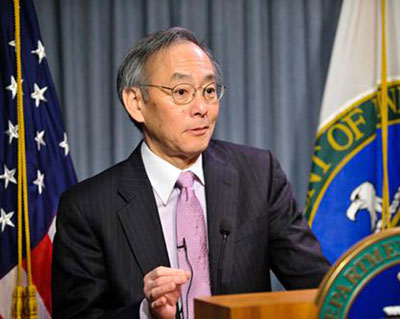 Secretary of Energy Steven Chu announced on Feb. 1 his intention to step down as Secretary of Energy and return to teaching and research. DOE Photo
In a Feb. 1 letter to Department of Energy employees, Energy Secretary Steven Chu announced his intention to return to academia and highlighted progress across the Department of Energy over the last four years. "Serving the country as Secretary of Energy, and working alongside such an extraordinary team of people at the department, has been the greatest privilege of my life. While the job has had many challenges, it has been an exciting time for the department, the country, and for me personally. "I've always been inspired by Dr. Martin Luther King, who articulated his Dream of an America where people are judged not by skin color but 'by the content of their character.' In the scientific world, people are judged by the content of their ideas. Advances are made with new insights, but the final arbitrator of any point of view are experiments that seek the unbiased truth, not information cherry picked to support a particular point of view. The power of our work is derived from this foundation. "I have worked each day to move the department in a direction where the political leadership and highest levels of career managers have the intellectual curiosity and wisdom to learn from the people who reported to them and where the subject matter experts – which should include managers at the highest levels – as well as employees at our national laboratories welcome their counsel and help. I grew up and matured in organizations where a graduate student or staff scientist could have a discussion with a company department head, a professor, a national lab director and be heard, not because of their rank in the organization, but because of the quality of their ideas. "I want to conclude by making a few observations about the importance of the Department of Energy missions to our economic prosperity, dependency on foreign oil and climate change. "…I would like to return to an academic life of teaching and research, but will still work to advance the missions that we have been working on together for the last four years. "In the short term, I plan to stay on as secretary past the ARPA-E Summit at the end of February. I may stay beyond that time so that I can leave the Department in the hands of the new secretary. The journey that I began with you four years ago will continue for many years. I began my message talking about my vision of what I wanted to do with the department. Some of those goals have been realized, and we have planted many seeds together… some of the most significant work may not be known for decades. What matters is that our country will reap the benefits of what we have started. "It has been a great honor and privilege to work with all of you." Secretary Chu's complete letter is posted online at: http://energy.gov/articles/letter-secretary-steven-chu-energy-department-employees-announcing-his-decision-not-serve. |
||||
|
|
||||
U.S. Patent Office Publishes Rules for New First-Inventor-to-File System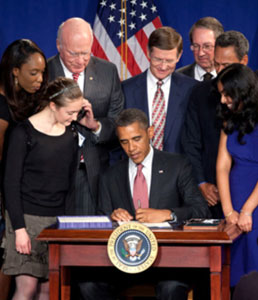 President Barack Obama signed the America Invents Act on Sept. 16, 2011, while at the Thomas Jefferson High School for Science and Technology in Alexandria, Va.
The United States Patent and Trademark Office (USPTO) has published the final rules for implementing the new first-inventor-to-file provision of the Leahy-Smith America Invents Act (AIA) that will go into effect on March 16. The provision, one of the hallmarks of the AIA, is a major step toward aligning the U.S. patent system with those of the United States' major trading partners, allowing greater consistency in the prosecution and enforcement of U.S. patents. The AIA also includes safeguards to ensure that only an original inventor or assignee may be awarded a patent under the first-inventor-to-file system. The first-inventor-to-file provision of the AIA goes into effect on March 16, and represents the final implementation of the changes mandated by the AIA. The USPTO, which is within the U.S. Department of Commerce, has also published final examination guidelines setting forth the agency's interpretation of how the first-inventor-to-file (FITF) provision alters novelty and obviousness determinations for an invention claimed in a patent application. In particular, the agency's final examination guidelines inform the public and patent examiners how the AIA's changes to the novelty provisions of law alter the scope of what is prior art to a claimed invention and how the new grace period operates. "Migration to a first-inventor-to-file system will bring greater transparency, objectivity, predictability, and simplicity to patentability determinations and is another step towards harmonizing U.S. patent law with that of other industrialized countries," said Teresa Stanek Rea, acting under secretary of commerce for intellectual property and acting USPTO director. The AIA authorizes derivation proceedings before the USPTO, which will ensure that a person will not be able to obtain a patent for an invention that he or she did not actually invent. The AIA also creates a one-year grace period, which will ensure that the patentability of an invention is not defeated by the inventor's own disclosures, disclosures of information obtained from the inventor, or third-party disclosures of the same information as the inventor's previous public disclosures. The new micro-entity (75 percent) discounts for patent applicants also make it more affordable for independent inventors to seek patents. The USPTO will provide more information on the first-inventor-to-file final rules and examination guidelines at a public training session to be held on March 8 at the USPTO's headquarters in Alexandria, Va. The training session will be webcast. Details on webcast access will be available on the AIA micro-site at: www.uspto.gov/AmericaInventsAct. The Federal Register publication – Changes to Implement First Inventor to File Provisions of Leahy-Smith America Invents Act – can be found at: http://federalregister.gov/a/2013-03453. The Federal Register publication – Implementing First Inventor to File Provisions of Leahy-Smith America Invents Act: Examination Guidelines – is online at: http://federalregister.gov/a/2013-03450. To subscribe to USPTO email updates, visit the USPTO Subscription Center at: www.uspto.gov/subscribe. More information and reference links regarding First-Inventor-to-File provisions are available on the Patents Examination page at: http://www.uspto.gov/aia_implementation/patents.jsp# The complete version of this Feb. 13 USPTO news release is online at: http://www.uspto.gov/news/pr/2013/13-10.jsp. |
||||
|
|
||||
Below the Fold: |
||||
Lawyer to Speak About New Patent Law on March 6; Lab Staff to be Recognized for 'Bright Ideas'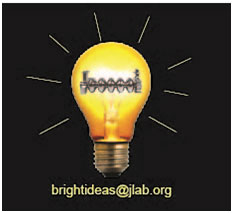 When the America Invents Act goes into effect in March, it will introduce fundamental changes to the U.S. patent system. The Technology Review Committee will host an informational seminar on how these changes will impact inventors at Jefferson Lab on Wednesday, March 6, at 11 a.m. in CEBAF Center room F113. Just before the seminar, lab management and TRC members will take a few minutes to give "Bright Ideas" recognition to lab staff that made patent disclosures of new Intellectual Property in 2012. Lab Community Invited to 12 GeV Upgrade Cryomodule Milestone Event on March 12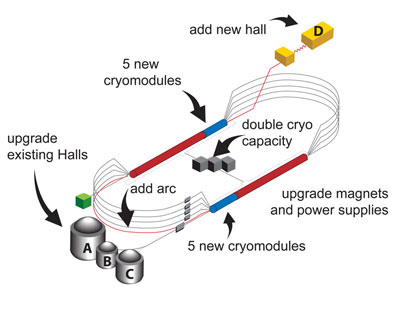 Jefferson Lab staff and users are invited to the Test Lab Addition High Bay at 11:30 a.m. on March 12 to celebrate the completion of the 10 cryomodules designed and built for CEBAF's 12 GeV Upgrade project. This graphic shows where the new cryomodules are being installed in the two linear accelerator sections of CEBAF.
Jefferson Lab staff and users are invited to the Test Lab Addition High Bay from 11:30 a.m.-12 p.m. on Tuesday, March 12, to celebrate the completion of the 10 cryomodules designed and built for CEBAF's 12 GeV Upgrade. "C100" is the lab's general designation for the 10 cryomodules built as part of the upgrade, and refers to an early design goal for the modules accelerating potential. In fact, the new modules were designed to achieve 108 Megavolts (MV) of accelerating potential per cryomodule, and there was a successful demonstration of this performance in May 2012. The original CEBAF cryomodule design was for 20 MV per cryomodule. To mark this significant milestone in the 12 GeV Upgrade Project, members of the SRF working groups and the cryomodule-naming contest winners will receive a commemorative C100 T-shirt. Nearly 160 submissions were sent in for consideration during the cryomodule naming contest. While some submissions entered just one word or name, many of the submissions included 10 or more entries. Steve Suhring, Accelerator Operations, chaired the seven-member committee appointed by Lab Director Montgomery to evaluate the names for final vote. "We looked at more than 450 names suggested by the lab community, and debated about the best selection. Ultimately, we wanted these names to say something about the character of Jefferson Lab and the people who work here." The committee organized and evaluated the entries before winnowing them down to 10 names in each of four overarching categories: research words related to the lab's mission, physicists who made major contributions to the science that underpins the lab's research, terms directly related to the lab's research program, and influential historical figures and sites of the region. In lab-wide voting, the category receiving the most votes was Jefferson Lab Descriptions – containing words that describe the spirit, culture and mission of the lab: Each of the C100 cryomodules will have one of these names stenciled onto it. The installation and check-out of the new cryomodules will be completed this summer, and the commissioning of the "new" 12 GeV accelerator will start in the autumn. Jefferson Lab Hosts Lecture on 'Guesstimating' with ODU Physics Professor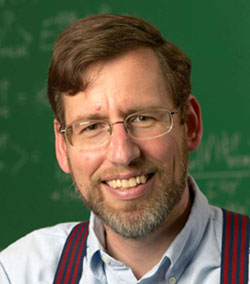 Old Dominion University Physicist, Larry Weinstein, will present a public talk titled "Guesstimating the Environment" at 7 p.m. on March 5 at Jefferson Lab as part of the lab's ongoing Science Series lectures. Weinstein has authored two books on "guesstimation."
Jefferson Lab will hold a spring Science Series Lecture on Tuesday, March 5, starting at 7 p.m. in the CEBAF Center auditorium. Guest speaker will be Physicist Larry Weinstein, Old Dominion University, presenting "Guesstimating the Environment." He poses the questions: Paper or plastic? Gasoline or electric cars? Ethanol or gasoline? Local or imported food? And points out that we are constantly bombarded by environmental questions and by contradictory answers from "experts." The talk will show how a person can cut through the fog of numbers to answer these questions for oneself, not precisely, but good enough, according to Weinstein. "We will cover the principles of estimating, introduce the 'Goldilocks' categories of answers, and then look at some of the big (and small) environmental questions of our time." The lecture is free and open to students and adults with an interest in science. It will begin at 7 p.m., in the CEBAF Center auditorium and will last about an hour. Seating in the auditorium and overflow area is available on a first-come, first-served basis. People arriving once capacity has been reached will be turned away. All those under age 16 must be accompanied by a parent or responsible adult. Everyone over 16 is asked to carry a valid photo ID. Security guards may perform ID, parcel and vehicle checks. For directions and additional information about Jefferson Lab public lectures, visit: http://education.jlab.org/scienceseries/index.php or contact Christine Wheeler, email at wheelerc@jlab.org or call 757-269-7560. Lectures are added to the Science Series video archive for on-demand viewing upon approval from the presenter. Thomas Jefferson Team Takes Top Honors at Virginia High School Science Bowl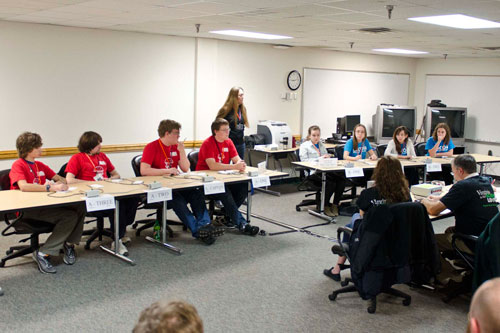 Jefferson Lab volunteers prepare to conduct a round robin match between the Loudoun School for the Gifted team (left), from Ashburn, and the team from Charlottesville High School, Charlottesville.
After an intense day of competition among the 23 teams competing at the 2013 Virginia Regional High School Science Bowl, the team from Thomas Jefferson High School for Science and Technology, Alexandria, walked away with top honors. The team took home a $750 check for its school, a team trophy, individual medals and the regional banner that the team will take to nationals. The team will also receive an expenses-paid trip to participate in the National Science Bowl finals – in Washington, D.C., April 25-29. Following TJHSS&T with a strong second-place finish was the team from Langley High School, McLean, coached by Leah Puhlick. This was Langley's best finish ever in its years of competing in the annual academic competition. The Langley team made it through the round-robin matches undefeated and fell only to TJHSS&T during in the double-elimination finals. For second place, the team won a $500 check for its school and a trophy. Finishing in third was the team from St. Christopher's School, Richmond. The team is coached by Vicki Hurt and Alina Cichocki. The team took home a $300 check for its school and a team trophy. Fourth place went to the Bishop Sullivan Catholic High School team, Virginia Beach, coached by Bill Dunn and Carol Stapanowich. They received a team trophy. A number of teams, eliminated from competition after the morning rounds, stayed for the afternoon to participate in an event dubbed the Stay All Day Contest. The teams participated in up to three activities, each one presenting a different type of design and/or engineering challenge. The team from Robert E. Lee High School, Springfield, and coached by Richard Priest and Lisa Eggart, won with the best composite score. For their effort, the team received a $300 check for its school. Individual prizes were presented to the RELHS team members as well as to the team members earning the highest scores in each activity. 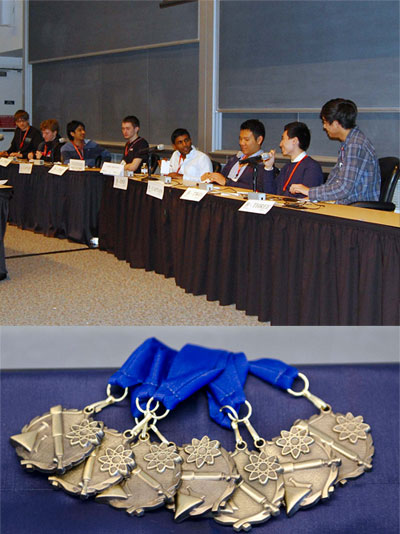 Top photo: The final match of the day pitted the Langley High School team (foreground), from McLean, against the undefeated team from the Thomas Jefferson High School for Science and Technology, Alexandria. At the final buzzer the TJ team won 72 to 44 over Langley HS. Above: Each member of the TJ team received a Science Bowl regional championship medal.
At the awards ceremony, Jan Tyler, JLab's Science Education manager and Science Bowl coordinator, applauded the 114 students who competed at the event for the range and depth of knowledge they exhibited and for the effort they put forth in preparing for the competition. She also commended the 34 teachers who coached the teams, calling them "truly awesome" for the work they did to prepare their teams for the rigorous academic competition. She thanked lab leadership for their support in hosting the event, and for the more than 50 volunteers that took part in conducting the event. In a U.S. Department of Energy news release, Secretary Steven Chu said, "Congratulations to the students at Thomas Jefferson High School for Science and Technology for their achievements in science, technology, engineering and math. Providing opportunities like the National Science Bowl to challenge today's students is an essential part of keeping America competitive in a rapidly advancing world." The DOE created the National Science Bowl in 1991 to encourage students to excel in mathematics and science and to pursue careers in these fields. More than 200,000 students have participated in the National Science Bowl, the nation's largest science competition, throughout its 22 year history. Over the next several months, more than 9,000 high school students and 5,000 middle school students will compete in 70 high school and 48 middle school regional Science Bowl tournaments. Students, in teams of four or five, compete in the fast-paced Jeopardy-style format where they solve technical problems and answer questions in all branches of science and math. Most teams are coached by teachers from the students' schools and spend several months preparing for the regional competitions. Many states have one regional or statewide Science Bowl competition, while larger states, such as California and Texas, hold several regional competitions. The regional tournaments, which host 15-50 teams, are sponsored by federal agencies, national laboratories, institutions of education, and non-profit organizations. Jefferson Lab will host the Virginia Regional Middle School Science Bowl on Saturday, March 2. Eighteen schools are registered to compete. Former Jefferson Lab Staff Member Receives Award for Research Excellence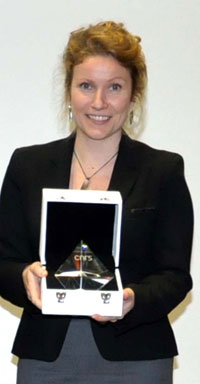 Maud Baylac, a former Jefferson Lab staff scientist, received France's Crystal CNRS Award at an awards event in Grenoble on Dec. 11.
Maud Baylac, formerly a staff scientist in Jefferson Lab's injectors and sources group, has been named a recipient of France's Crystal CNRS Award. Baylac, a research engineer at the Laboratory for Subatomic Physics and Cosmology (CNRS-LPSC) in Grenoble, received the Crystal CNRS for her work on accelerators, in an awards ceremony on Dec. 11. Baylac has co-headed the cluster-ion sources and accelerators at LPSC since 2010. She was recruited to the LPSC staff in 2004, and has occupied a leadership and management role for her department since 2006. She is currently contributing to the European project GUINEVERE (a preliminary step on the MYRRHA project path) that is studying the feasibility of a nuclear reactor driven by an accelerator system. While a member of JLab's injector group, she mainly devoted herself to optimizing the polarization of the electron beam, an essential parameter for experiments with CEBAF. She first came to JLab in 1998 as a student, in conjunction with work for her Ph.D. thesis, which was for the measurement of electron beam polarization with the Hall A Compton Polarimeter. For three years she traveled between the Universite Claude Bernard and Commissariat a L'Energie Atomique, Saclay, and Newport News. While at JLab, Baylac was involved in the installation and commissioning of the Compton Polarimeter and the first measurements taken with the system. Baylac received the SURA Thesis Prize in 2000 for her work, titled: A Measurement of the Polarization of the Jefferson Lab Electron Beam Via the Compton Effect for the HAPPEX Experiment on Parity Violating Elastic Electron-Proton Scattering. The Southeastern Universities Research Association established the yearly prize to recognize the vital role played by graduate students in the scientific mission of Jefferson Lab, and to recognize outstanding research efforts by SURA-member-university students. The web site for the Laboratory for Subatomic Physics and Cosmology is: The Crystal CNRS Award announcement is online at: Baylac is on LinkedIn at: http://www.linkedin.com/pub/maud-baylac/5/13a/621 Milestones for January 2013Hello These Milestone entries, listed alphabetically, are full-time, term, casual and student actions posted by Human Resources for January 2013. Jefferson Lab is currently seeking qualified individuals for nearly 10 positions, including engineering, technical, administration and intern positions. All current employment opportunities are posted at: http://www.resumeware.net/jlabs_rw/jlabs_web/job_search.cfm. (Please note this is a new web link.) Information about career opportunities at Jefferson Lab is available at: https://www.jlab.org/job-openings Lab Mourns Passing of Retired Staff Member, Frank Folsom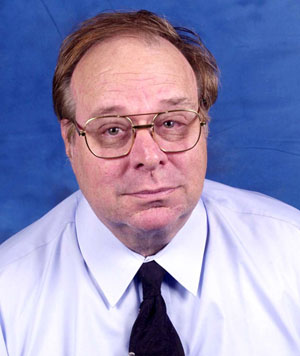 Frank Folsom, a long-time lab staff member who retired in January 2010, passed away on Feb. 8. He was instrumental in developing and setting up portions of the lab's in-house, superconducting radiofrequency fabrication capability and for carrying out critical aspects of the machining work on cryomodule components.
Willis Franklin "Frank" Folsom, Jr., 74, a long-time Jefferson Lab staff member, who retired from the lab in January 2010, passed away on Feb. 8. In an announcement of Folsom's passing to the SRF (superconducting radiofrequency) group, Charlie Reece wrote: "For those of you who were not familiar with Frank Folsom, Frank was responsible for setting up the first niobium (Nb) machining facility at JLab. He helped me procure and commission the old Mazak milling machine, and establish here the Nb machining parameters imported from Cornell. He machined all of the HOM (high order mode) elbows, Nb beamtubes, and FPC waveguide extensions for the CEBAF construction, integrating the machining with the EBW (electron beam welder) of the components by John Brawley. (See Technote: 93-099.pdf) This was the largest actual in-house production fabrication effort accomplished in JLab SRF. After this big push, the Mazak machining center was transitioned to the Engineering Division for administration and Frank remained in SRF, helping with a variety of activities, including sheet metal work, inventory, and a little of his first love, which was electronic instrumentation, having previously worked on the Hastings vacuum gauges. We remember Frank as always being agreeable and positive, trying to contribute to the lab in any way he could. We are saddened at his passing and extend our sympathy to his family." According to the Daily Press, Folsom was a native and lifelong resident of Hampton. In 1986, as a mechanical technician, he retired from Teledyne Hasting - Radist. He was a lifetime member of the Hampton Volunteer Fire Department. A funeral with Fire Department Honors was held on Feb. 16, in the Mausoleum Chapel of Parklawn Memorial Park, Hampton. The Daily Press obituary and guest book is online at: http://www.legacy.com/obituaries/dailypress/obituary.aspx?n=willis-franklin-folsom&pid=163024589&fhid=11383#fbLoggedOut |
||||
|
The On Target newsletter is published monthly by the Thomas Jefferson National Accelerator Facility (Jefferson Lab), a nuclear physics research laboratory in Newport News, Virginia, operated by Jefferson Science Associates, LLC, for the U.S. Department of Energy's Office of Science. Possible news items and ideas for future stories may be emailed to jlabinfo@jlab.org, or sent to the Jefferson Lab Public Affairs Office, Suite 15, 12000 Jefferson Avenue, Newport News, VA 23606
|
||||


 In retrospect, it seems that every career step Steve Neilson has taken has in some way helped prepare him for his current position as safety and occupational health manager....
In retrospect, it seems that every career step Steve Neilson has taken has in some way helped prepare him for his current position as safety and occupational health manager....  In a Feb. 1 letter to Department of Energy employees, Energy Secretary Steven Chu announced his intention to return to academia.....
In a Feb. 1 letter to Department of Energy employees, Energy Secretary Steven Chu announced his intention to return to academia.....  The United States Patent and Trademark Office has published the final rules for implementing the new first-inventor-to-file....
The United States Patent and Trademark Office has published the final rules for implementing the new first-inventor-to-file....